
St. John African Methodist Episcopal Church was the first church for African Americans in Nebraska, organized in North Omaha in 1867. It is located at 2402 North 22nd Street in the Near North Side neighborhood. The building is listed on the National Register of Historic Places. The building was constructed in the center of Omaha's North Side in the Prairie School architecture style. Prairie School architecture is rare, and this architectural gem in urban Nebraska is particularly unusual for being designed and built in the 1920s, after the Prairie Style's rapid loss of popularity beginning after 1914.

Christ Church is a historic church located at Melendy Hill Road and US Route 5 in Guilford, Vermont. Built in 1817 and later given Gothic Revival styling, it was the first Episcopal Church in Vermont. On May 13, 1982, it was added to the National Register of Historic Places. It is now owned by the Episcopal Diocese of Vermont and maintained by a local nonprofit organization.
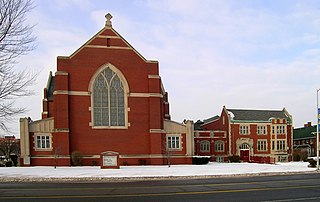
The St. John's Christian Methodist Episcopal Church is a church located in Detroit, Michigan. It was built as the North Woodward Congregational Church, listed on the National Register of Historic Places in 1982, and designated a Michigan State Historic Site in 1998.

Mount Zion Methodist Church is located on Primrose Avenue in Somers, New York, United States. It is a white clapboard-sided church built near the end of the 18th century, and heavily renovated around 1860. A century later, in 1970, it was severely vandalized.

Old Christ Church is a historic Episcopal church at the junction of Vermont Route 12 and Gilead Brook Road in Bethel, Vermont. Built in 1823, it is a well-preserved Federal period church, lacking modern amenities such as electricity and plumbing. The church was added to the National Register of Historic Places in 2008. It is used for services only during the summer.

Bethel African Methodist Episcopal Church is a historic African Methodist Episcopal Church in Springtown, New Jersey, United States. The church was part of two free negro communities, Othello and Springtown, established by local Quaker families. The congregation was established in 1810 in Greenwich Township as the African Methodist Society and joined the African Methodist Episcopal Church in 1817. A previous church building was burned down in the 1830s due to arson and the current structure was built between 1838 and 1841.

Mount Zion African Methodist Episcopal Church and Mount Zion Cemetery is a historic church and cemetery located at 172 Garwin Road in Woolwich Township, New Jersey, United States. The church was a stop on the Greenwich Line of the Underground Railroad through South Jersey operated by Harriet Tubman for 10 years. The church provided supplies and shelter to runaway slaves on their way to Canada from the South. The church and cemetery were part of the early 19th-century free negro settlement sponsored by Quakers known as Small Gloucester.

Harmony Hill Methodist Church is a Methodist Episcopal house of worship affiliated with the United Methodist Church and located about one mile north of the village of Stillwater in Stillwater Township, in the Sussex County, New Jersey.
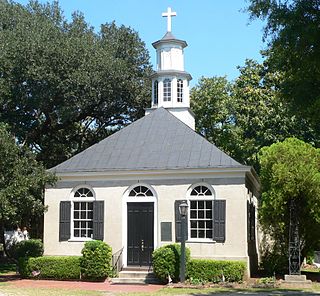
Christ Episcopal Church is a church located in Mount Pleasant, South Carolina.
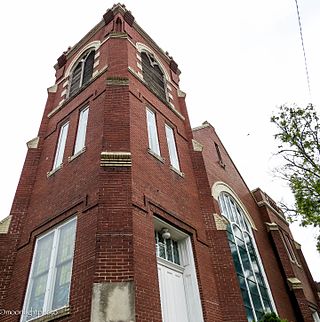
Asbury United Methodist Church, originally Highland Park Methodist Episcopal Church, is a historic church on Bailey Avenue in Chattanooga, Tennessee.

The Salem Methodist Episcopal Church and associated Salem Walker Cemetery is a historic church and cemetery located at 7150 Angle Road, in Salem Township, Michigan with a postal designation of Northville, Michigan. The church and cemetery were added to the National Register in 1992 and designated a Michigan State Historic Site in 1991. The church is significant as one of the least-altered Greek Revival churches existing in the state of Michigan.

The Church of St. Philip-in-the-Field and Bear Canon Cemetery is a historic church building and cemetery in Sedalia, Colorado. It was added to the National Register of Historic Places in 1973.

Middlefork Methodist Episcopal Church is a historic church on the South of US 169 on the east side of Middle Fork, Grand Road in Redding, Iowa, United States. It is now known as Middlefork United Methodist Church.

The German Methodist Episcopal Church, also known as St. Paul's German Methodist Episcopal Church, is a historic church building in Burlington, Iowa, United States. The German Methodist Episcopal Church was organized in Burlington in 1845. It was the second of eight German congregations established in the city of various denominations. The Reverend Sebastian Barth, the first pastor, initially held services in a small frame house, and then in the basement of another church. The first permanent home for the congregation was a small brick church that was built in 1848. This structure was built from 1868 to 1869. It is a Victorian Gothic structure with Romanesque elements. The stone for the exterior was quarried from the site where the church was built.
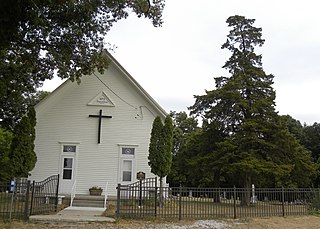
Pleasant Grove Community Church and Cemetery is a historic church building at 56971 170th Street in Ames, Iowa. The church was founded in 1873. The building was completed in 1874 and was added to the National Register of Historic Places in 2010.

Washington Prairie Methodist Church is a historic church building located southeast of Decorah, Iowa, United States. The congregation was established by Ole Peter Petersen. He returned to his native Norway in 1853 and founded the first Methodist congregation there. Washington Prairie Methodist is considered the mother church of Methodism in Norway. In the early years the congregation met in private houses. They built this church building themselves from 1863 to 1868. With its pediments and entablature/cornice it is Greek Revival in style. However, the windows on the side elevations are Gothic. It also features a round-arch entry on its gabled end. By 1888 services were only held here quarterly, and continued until about 1920, when the church was officially closed. Over the years some vandalism and settling of the structure occurred. The Vesterheim Norwegian-American Museum in Decorah restored the church and adjacent cemetery in 1972. The bishop of the North European Methodist Conference participated in its re-dedication later that year. It was listed on the National Register of Historic Places in 1980.

Roberts Park Methodist Episcopal Church, whose present-day name is Roberts Park United Methodist Church, was dedicated on August 27, 1876, making it the oldest church remaining in downtown Indianapolis. Diedrich A. Bohlen, a German-born architect who immigrated to Indianapolis in the 1850s, designed this early example of Romanesque Revival architecture. The church is considered one of Bohlen's major works. Constructed of Indiana limestone at Delaware and Vermont Streets, it has a rectangular plan and includes a bell tower on the southwest corner. The church is known for its interior woodwork, especially a pair of black-walnut staircases leading to galleries (balconies) surrounding the interior of three sides of its large sanctuary. The church was added to the National Register of Historic Places on August 19, 1982. It is home to one of several Homeless Jesus statues around the world, this one located behind the church on Alabama Street.

Benjamin Chapel and Richwoods Cemetery, also known as Richwoods Methodist Protestant Church or simply Richwoods Church, is a historic church located south of the unincorporated community of Trenton in rural Henry County, Iowa, United States. This front gable, frame church building was built by a congregation of the Methodist Protestant Church in 1877. The congregation itself was formed sometime after 1843. The building has two entrances on the main facade, one for men and the other for women. The genders then sat separately on their respective sides of the church building. The interior still has the original pews with dividers. There is also a small tower, capped with a spire, above the facade. The Methodist Protestant Church continued to maintain the building until 1921 when they sold it to the Benjamin Chapel Association. The association was named for Benjamin B. Allender, who was instrumental in building the church. Regular church services and Sunday school classes were held until 1940, and occasionally until 1952. The cemetery behind the church was a burial ground for the Methodist congregation as well as other residents from the Richwoods area. It is still an active burial ground. The church and cemetery were added to the National Register of Historic Places in 2015.
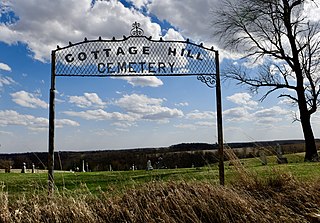
The Cottage Hill Methodist–Episcopal Cemetery is a historic site located in Concord Township, Dubuque County, Iowa, United States. The cemetery was established in 1843 when the first burial took place. It is significant as a representation of the pioneer settlement era and the development of the village of Cottage Hill, no longer extant, and the surrounding area. Its period of significance continues until 1909 when the last settler was buried here. The last burial here was in 1991.






















